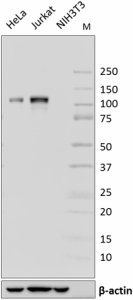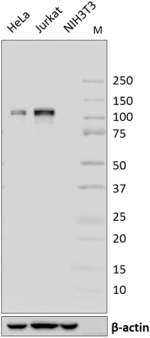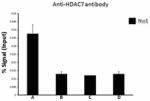- Clone
- 11C7C49 (See other available formats)
- Regulatory Status
- RUO
- Other Names
- Histone deacetylase 7, HD7, HDAC7a
- Isotype
- Mouse IgG1, κ
- Ave. Rating
- Submit a Review
- Product Citations
- publications

-

Total cell lysates (15 µg total protein) from HeLa, Jurkat, and NIH/3T3 cells were resolved by 4-20% Tris-Glycine gel electrophoresis, transferred to a nitrocellulose membrane, and probed with 1.0 µg/mL (1:500 dilution) of Purified anti-HDAC7 Antibody, clone 11C7C49, overnight at 4°C. Proteins were visualized by chemiluminescence detection using HRP goat anti-mouse IgG Antibody (Cat. No. 405306) at a 1:3000 dilution. Direct-Blot™ HRP anti-β-actin Antibody (Cat. No. 664804) was used as a loading control at a 1:5000 dilution (lower). Lane M: Molecular Weight marker. -

Chromatin Immunoprecipitation (ChIP) was performed using commercial Protein-G coated 96 well high-throughput ChIP assay kit by loading 3µg of cross-linked chromatin samples from Jurkat cells with either A) 1:50 dilution of Go-ChIP-Grade™ Purified anti-HDAC7 Antibody (Clone 11C7C49), B) equal amount of Purified Mouse IgG1, κ Isotype Control Antibody, or C) competitor’s ChIP-grade Purified anti-HDAC7 Antibody and D) equal amount of matched Isotype Control Antibody as recommended by the manufacturer. The enriched DNA was purified and quantified by real-time qPCR using primers targeting human NucE gene region. The amount of immunoprecipitated DNA in each sample is represented as signal relative to the 5% of total amount of input chromatin.
| Cat # | Size | Price | Quantity Check Availability | Save | ||
|---|---|---|---|---|---|---|
| 683502 | 100 µg | 249€ | ||||
Histone deacetylases (HDACs) regulate a variety of biological processes by deacetylating lysine residues in the N-terminal tails of core histones and non-histone proteins. HDAC7 is a class IIa histone deacetylase and its enzymatic activity is dependent on the interaction with HDAC3. HDAC7 is highly expressed in CD4+CD8+ double-positive thymocytes and has been suggested to repress the expression of Nur77 through the transcription factor MEF2D. HDAC7 is mostly localized to the nucleus and can be sequestrated in the cytoplasm by interacting with 14-3-3 protein during T cell receptor activation. The nuclear export of HDAC7 leads to the expression of Nur77 and apoptosis. HDAC7 has been shown to regulate the maturation of osteoclast and osteoblast, as well as the development of muscle and blood vessel.
Product DetailsProduct Details
- Verified Reactivity
- Human
- Antibody Type
- Monoclonal
- Host Species
- Mouse
- Immunogen
- Synthetic HDAC7 peptide conjugated to KLH (1-17 a.a.)
- Formulation
- Phosphate-buffered solution, pH 7.2, containing 0.09% sodium azide.
- Preparation
- The antibody was purified by affinity chromatography.
- Storage & Handling
- The antibody solution should be stored undiluted between 2°C and 8°C.
- Application
-
WB - Quality tested
ChIP - Verified - Recommended Usage
-
Each lot of this antibody is quality control tested by Western blotting. For Western blotting, the suggested use of this reagent is 0.5 - 2.5 µg per ml. For ChIP applications, the suggested dilution is 1:50-1:100 by volume. It is recommended that the reagent be titrated for optimal performance for each application.
- RRID
-
AB_2572024 (BioLegend Cat. No. 683502)
Antigen Details
- Structure
- 952 amino acids with a predicted molecular weight of 102.9 kD. Contains a histone deacetylase domain.
- Distribution
-
Cytoplasm and the nucleus.
- Function
- HDAC7 mediates deacetylation of lysine residues in the N-terminal tails of core histones. It plays important roles in the regulation of T-cell differentiation and development of muscle and blood vessel.
- Interaction
- HDAC7 interacts with HDAC1, HDAC2, HDAC3, HDAC4, HDAC5, FOXP3, KAT5, EDNRA, KDM5B, NCOR1, NCOR2, SIN3A, SIN3B, RBBP4, RBBP7, MTA1L1, SAP30 and MBD3.
- Biology Area
- Cell Biology, Chromatin Remodeling/Epigenetics, Neuroscience, Transcription Factors
- Antigen References
-
1. Barneda-Zahonero B, et al. 2013. PLoS Genet. 9:e1003503.
2. Pham L, et al. 2011. J. Biol. Chem. 286:12056.
3. Li S, et al. 2011. Mol. Cancer 10:18.
4. Gao C, et al. 2010. Biochim. Biophys. Acta. 1803:1186.
5. Margariti A, et al. 2009. J. Cell. Sci. 122:460.
6. Parra M, et al. 2007. Genes Dev. 21:638. - Gene ID
- 51564 View all products for this Gene ID
- UniProt
- View information about HDAC7 on UniProt.org
Related Pages & Pathways
Pages
Related FAQs
Other Formats
View All HDAC7 Reagents Request Custom Conjugation| Description | Clone | Applications |
|---|---|---|
| Purified anti-HDAC7 | 11C7C49 | WB,ChIP |
Compare Data Across All Formats
This data display is provided for general comparisons between formats.
Your actual data may vary due to variations in samples, target cells, instruments and their settings, staining conditions, and other factors.
If you need assistance with selecting the best format contact our expert technical support team.
 Login / Register
Login / Register 









Follow Us